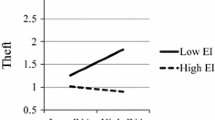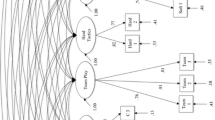Abstract
We investigated the relationship between guilt proneness and counterproductive work behavior (CWB) using a diverse sample of employed adults working in a variety of different industries at various levels in their organizations. CWB refers to behaviors that harm or are intended to harm organizations or people in organizations. Guilt proneness is a personality trait characterized by a predisposition to experience negative feelings about personal wrongdoing. CWB was engaged in less frequently by individuals high in guilt proneness compared to those low in guilt proneness, controlling for other known correlates of CWB. CWB was also predicted by gender, age, intention to turnover, interpersonal conflict at work, and negative affect at work. Given the detrimental impact of CWB on people and organizations, it may be wise for employers to consider guilt proneness when making hiring decisions.
Similar content being viewed by others
Notes
In addition, the survey also included assessments of organizational citizenship behavior (OCB) and morality judgments of counterproductive and citizenship behaviors. Because those scales are not relevant to the current study, we do not discuss them further. Information about these measures are available from the authors upon request.
The CWB-C items were embedded in a longer list of items that also included 20 organizational citizenship behavior (OCB) items (Fox et al. 2011) interspersed with the 32 CWB items. Because our research question concerned CWB rather than OCB, we do not discuss the OCB findings further (however, information is available from the authors upon request).
Although the alpha level of .97 was particularly high, it is consistent with prior research using the CWB-C, which generally finds alpha levels of .90 or higher for the longer (45-item) CWB-C (see Paul Spector’s website for psychometric information about the scale: http://shell.cas.usf.edu/~pspector/scales/cwbcover.html). The authors of the CWB-C point out that the measure is behavior checklist (i.e., a causal indicator scale) containing items that are not parallel assessments of a single underlying construct (Spector et al. 2006). For this type of measure, internal consistency is not a good indicator of reliability (Bollen and Lennox 1991; Edwards and Bagozzi 2000). For further discussion of the limitations of internal consistency as an indicator of reliability, see McCrae et al. 2011; Schmitt 1996.
Although the one-factor model had excellent fit, we also attempted to estimate a five-factor model of the CWB-C; however, factor scores could not be computed because the latent variable covariance matrix was not positive definite.
In addition to analyzing total CWB-C scores, we analyzed each of the five CWB-C subscales separately (calculated as sum scores, rather than factor scores). The guilt proneness factor was significantly negatively correlated with each of the five subscales, ranging from r(389) = −.28, p < .001 for production deviance, to r(389) = −.22, p < .001 for theft.
References
Berry, C. M., Carpenter, N. C., & Barratt, C. L. (2012). Do other-reports of counterproductive work behavior provide an incremental contribution over self-reports? A meta-analytic comparison. Journal of Applied Psychology. doi:10.1037/a0026739.
Bolger, N., Davis, A., & Rafaeli, E. (2003). Diary methods: Capturing life as it is lived. Annual Review of Psychology, 54, 579–617. doi:10.1146/annurev.psych.
Bollen, K., & Lennox, R. (1991). Conventional wisdom on measurement: A structural equation perspective. Psychological Bulletin, 110, 305–314.
Buhrmester, M., Kwang, T., & Gosling, S. D. (2011). Amazon’s Mechanical Turk: A new source of inexpensive, yet high-quality, data? Perspectives on Psychological Science, 6(1), 3–5. doi:10.1177/1745691610393980.
Cammann, C., Fichman, M., Jenkins, G. D., & Klesh, J. R. (1983). Assessing the attitudes and perceptions of organizational members. In S. E. Seashore, E. E. Lawler, P. H. Mirvis, & C. Cammann (Eds.), Assessing organizational change: A guide to methods, measures, and practices (pp. 71–138). New York: Wiley.
Chance, Z., Norton, M. I., Gino, F., & Ariely, D. (2011). Temporal view of the costs and benefits of self-deception. Proceedings of the National Academy of Sciences. doi: 10.1073/pnas.1010658108.
Cohen, T. R., Panter, A. T., Turan, N., & Morse, L. A. (2012). The WECT Project: Workplace experiences and character traits [project information]. Retrieved from http://WECTProject.org.
Cohen, T. R., Wolf, S. T., Panter, A. T., & Insko, C. A. (2011). Introducing the GASP scale: A new measure of guilt and shame proneness. Journal of Personality and Social Psychology, 100(5), 947–966. doi:10.1037/a0022641.
Dalal, R. S. (2005). A meta-analysis of the relationship between organizational citizenship behavior and counterproductive work behavior. Journal of Applied Psychology, 90(6), 1241–1255. doi:10.1037/0021-9010.90.6.1241.
Edwards, J. R., & Bagozzi, R. P. (2000). On the nature and direction of relationships between constructs and measures. Psychological Methods, 5, 155–174.
Fleeson, W., & Noftle, E. E. (2009). In favor of the synthetic resolution to the person-situation debate. Journal of Research in Personality, 43(2), 150–154.
Flynn, F. J., & Schaumberg, R. L. (2011). When feeling bad leads to feeling good: Guilt-proneness and affective organizational commitment. Journal of Applied Psychology. doi:10.1037/a0024166.
Fox, S., & Spector, P. E. (Eds.). (2005). Counterproductive work behavior: Investigations of actors and targets. Washington, DC: American Psychological Association.
Funder, D. C. (2008). Persons, situations and person–situation interactions. In O. P. John, R. Robins, & L. Pervin (Eds.), Handbook of personality (3rd ed., pp. 568–580). New York: Guilford.
Graham, J., Nosek, B. A., Haidt, J., Iyer, R., Koleva, S., & Ditto, P. H. (2011). Mapping the moral domain. Journal of Personality and Social Psychology, 101(2), 366–385. doi:10.1037/a0021847.
Haidt, J. (2007). The new synthesis in moral psychology. Science, 316(5827), 998.
Hampson, S. E. (2011). Personality processes: Mechanisms by which personality traits “get outside the skin”. Annual Review of Psychology. doi:10.1146/annurev-psych-120710-100419.
Iida, M., Shrout, P. E., Laurenceau, J.-P., & Bolger, N. (2012). Using diary methods in psychological research. In H. Cooper, P. Camic, D. Long, A. T. Panter, D. Rindskopf, & K. Sher (Eds.), APA handbook of research methodology in psychology (3 volumes). Washington, DC: APA Books.
Keenan, A., & Newton, T. J. (1985). Stressful events, stressors, and psychological strains in young professional engineers. Journal of Occupational Behavior, 6, 151–156.
Kish-Gephart, J. J., Harrison, D. A., & Treviño, L. K. (2010). Bad apples, bad cases, and bad barrels: Meta-analytic evidence about sources of unethical decisions at work. Journal of Applied Psychology, 95(1), 1–31. doi:10.1037/a0017103.
Marcus, B., Lee, K., & Ashton, M. C. (2007). Personality dimensions explaining relationships between integrity tests and counterproductive behavior: Big five, or one in addition? Personnel Psychology, 60(1), 1–34.
McCrae, R. R., Kurtz, J. E., Yamagata, S., & Terracciano, A. (2011). Internal consistency, retest reliability, and their implications for personality scale validity. Personality and Social Psychology Review, 15(1), 28–50. doi:10.1177/1088868310366253.
Muthén, L. K., & Muthén, B. O. (1998–2011). Mplus User’s Guide (6th ed.). Los Angeles, CA: Muthén & Muthén.
Nesselroade, J. R. (2007). Factoring at the individual level: Some matters for the second century of factor analysis. In R. Cudeck & R. C. MacCallum (Eds.), Factor analysis at 100: Historical developments and future directions (pp. 249–264). Mahwah, NJ: Erlbaum.
Rai, T. S., & Fiske, A. P. (2011). Moral psychology is relationship regulation: Moral motives for unity, hierarchy, equality, and proportionality. Psychological Review, 118(1), 57–75. doi:10.1037/a0021867.
Schmitt, N. (1996). Uses and abuses of coefficient alpha. Psychological Assessment, 8(4), 350–353.
Spector, P. (2011). The relationship of personality to counterproductive work behavior (CWB): An integration of perspectives. Human Resource Management Review, 21, 342–352.
Spector, P. E., & Fox, S. (2005). The stressor-emotion model of counterproductive work behavior. In S. Fox & P. E. Spector (Eds.), Counterproductive work behavior: Investigations of actors and targets (pp. 151–174). Washington, DC: American Psychological Association
Spector, P. E., Bauer, J. A., & Fox, S. (2010). Measurement artifacts in the assessment of counterproductive work behavior and organizational citizenship behavior: Do we know what we think we know? Journal of Applied Psychology, 95(4), 781–790. doi:10.1037/a0019477.
Spector, P. E., Fox, S., Penney, L., Bruursema, K., Goh, A., & Kessler, S. (2006). The dimensionality of counterproductivity: Are all counterproductive behaviors created equal? Journal of Vocational Behavior, 68(3), 446–460. doi:10.1016/j.jvb.2005.10.005.
Spector, P. E., & Jex, S. M. (1998). Development of four self-report measures of job stressors and strain: Interpersonal conflict at work scale, organizational constraints scale, quantitative workload inventory, and physical symptoms inventory. Journal of Occupational Health Psychology, 3, 356–367.
Stucky, B., Gottfredson, N. C., & Panter, A. T. (2012). Item factor analysis. In H. Cooper, P. Camic, D. Long, A. T. Panter, D. Rindskopf, & K. Sher (Eds.), APA handbook of research methodology in psychology. Washington, DC: APA Books.
Tangney, J. P., & Dearing, R. L. (2002). Shame and guilt. New York: Guilford Press.
Tangney, J. P., Stuewig, J., & Mashek, D. J. (2007). Moral emotions and moral behavior. Annual Review of Psychology, 58, 345–372.
Tangney, J. P., Youman, K., & Stuewig, J. (2009). Proneness to shame and proneness to guilt. In M. R. Leary & R. H. Hoyle (Eds.), Handbook of individual differences in social behavior (pp. 192–209). New York: Guilford.
U.S. Bureau of Labor Statistics. (2010a). 2010 Standard Occupational Classification (SOC User Guide). http://www.bls.gov/soc/#materials.
U.S. Bureau of Labor Statistics. (2010b). American time use survey. http://www.bls.gov/news.release/atus.nr0.htm.
Watson, D., Clark, L. A., & Tellegen, A. (1988). Development and validation of brief measures of positive and negative affect: The PANAS scales. Journal of Personality and Social Psychology, 54, 1063–1070.
Wirth, R. J., & Edwards, M. C. (2007). Item factor analysis: Current approaches and future directions. Psychological Methods, 12(1), 58–79. doi:10.1037/1082-989X.12.1.58.
Wolf, S. T., Cohen, T. R., Panter, A. T., & Insko, C. A. (2010). Shame proneness and guilt proneness: Toward the further understanding of reactions to public and private transgressions. Self & Identity, 9(4), 337–362. doi:10.1080/15298860903106843.
Yu, C.-Y. (2002). Evaluating cutoff criteria of model fit indices for latent variable models with binary and continuous outcomes. Doctoral dissertation, University of California, Los Angeles.
Zettler, I., & Hilbig, B. E. (2010). Honesty–humility and a person–situation interaction at work. European Journal of Personality, 24, 569–582.
Acknowledgments
This research was made possible through the support of the Tepper School of Business at Carnegie Mellon University and a grant by the Berkman Faculty Development Fund at Carnegie Mellon University. We also wish to thank the members of the Character Project at Wake Forest University for valuable feedback on this research.
Author information
Authors and Affiliations
Corresponding author
Rights and permissions
About this article
Cite this article
Cohen, T.R., Panter, A.T. & Turan, N. Predicting Counterproductive Work Behavior from Guilt Proneness. J Bus Ethics 114, 45–53 (2013). https://doi.org/10.1007/s10551-012-1326-2
Received:
Accepted:
Published:
Issue Date:
DOI: https://doi.org/10.1007/s10551-012-1326-2




